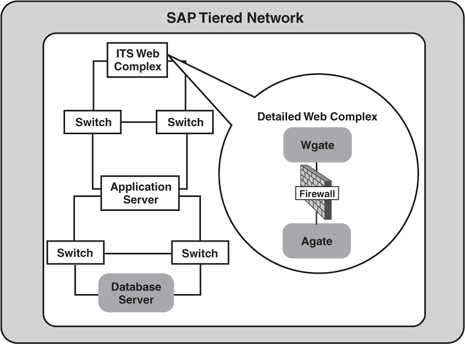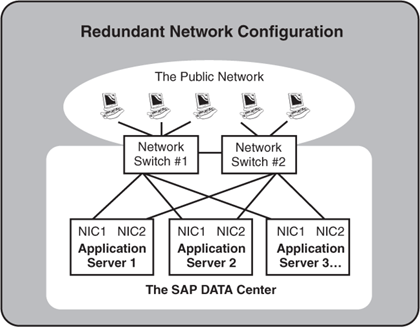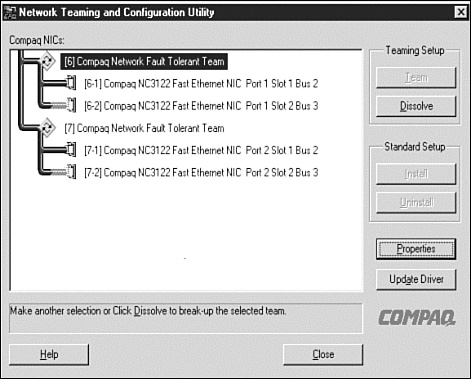Given that SAP is architected
to support a distributed three-tiered design, a slew of configurations
exist that can potentially impact high availability. There are similar
performance considerations as well, as the database, application, and
Web tier layers are all affected. For example, a back-end network is
recommended to interconnect the database and the application servers,
another network interconnects the application servers to the
Web/Internet layers, and a third public network addresses client
requirements. If you plan on pulling backups across the network (rather
than via a disk
subsystem that supports direct-attached SCSI or fibre channel tape
drives), a separate back-end network subnet is highly recommended in
this case, too.
In all cases, 100Mbit switched network segments
are warranted, if not Gigabit Ethernet. Backups are very
bandwidth-intensive, and if data is transmitted over otherwise crowded
network lines, database disconnects between your application and
database servers may result, for example. In this case more than any
other, therefore, Gigabit is warranted. Beyond network-enabled backups,
the second preferred subnet in which to leverage Gigabit includes the
network connecting the application and database servers, where traffic
can also be quite heavy. This is especially true as more and more
enterprises grow their mySAP environment by adding new SAP components
but insist on leveraging the same backend network.
The application/Web tier often consists of a
single 100Mbit subnet. As the application servers/Web servers are
usually not considered critical from a backup perspective, dedicated
network backup segments are usually not warranted in this case—these
servers usually contain fairly static data that lends itself to weekly
or other less-regular backups.
The Web tier is typically split, though. In the
case of SAP ITS implementations, for instance, an application gateway
(AGATE) connects to the SAP application servers, a Web gateway (WGATE)
connects to the AGATE, and the end users connect to the Web gateway.
Thus, the WGATE is often housed in a secure DMZ for access via the
Internet or an intranet, while the AGATE remains behind a firewall, safe
in its own secure subnet, as you see in Figure 1. In this way, the network accommodates the performance needs of the enterprise without sacrificing security.

Network Fault Tolerance
As I indicated earlier, there are many ways to
architect a network solution for SAP. Simply segregating each layer in
the solution stack achieves minimum performance metrics but does not
address availability. In fact, it actually increases the chance of a
failure, as more and more single-point-of-failure components are
introduced. Fault tolerance must therefore be built
into the design, not looked at afterwards. To this end, I will next
discuss the primary method by which network availability is designed
into the SAP data center, using an approach I call availability through redundancy.
Just as a redundant power infrastructure starts
with the servers, disk subsystems, and other hardware components, so too
does a redundant network infrastructure start with the networked
servers. Here, redundant network interface cards, or NICs, are specified, each cabled to redundant network hubs or switches, which are in turn connected to redundant routers. Figure 2 illustrates this relationship between the servers and a highly available network infrastructure.

Network fault tolerance starts not only with two
(or otherwise redundant) NIC cards, but also with OS-specific drivers
capable of pairing two or more physical network cards into one “virtual”
card. Hardware vendors often refer to this as teaming or pooling,
but other labels have been used for this important piece of the network
puzzle. Regardless of the label, the idea is simple: Pair two or more
network cards together, and use both concurrently for sending and
receiving the same exact packets of data. Then, use the data on one
network card/network segment (referred to as the “primary” NIC), and
discard or ignore the (exact same) data on the other NIC as long as the
network is up and things are going well. If a failure occurs with one of
the NICs, network segments, or hubs/switches on the “redundant” path,
continue processing packets as always on the primary path—business as
usual. However, if a failure occurs with one of the NICs, network
segments, or hubs/switches on the “primary” path, immediately turn to
the redundant path and start processing the data moving through this
path instead.
Today, most every operating system supports NIC
teaming for high availability. Many OSes also support variations of NIC
teaming geared toward improving performance, including network bonding,
adaptive load balancing, FastEtherChannel, Gigabit EtherChannel, and
more. Remember, though, that these latter variations do not necessarily
improve availability; teaming must either be inherently supported by or
used in conjunction with these different performance-enhancing
techniques or approaches.
|
Some operating systems simply do not support
specific network cards when it comes to NIC teaming. Further,
Microsoft’s cluster service specifically prohibits clustering the
private high-availability server interconnect, or heartbeat connection,
regardless of the type of NIC—Microsoft simply does not support teaming
the heartbeat. Network availability in this case is gained by
configuring the cluster service such that both the private and public
networks can send “still alive” messages between the cluster nodes. As
an aside, best practices suggest that the private network be preferred
for this activity, and that the public network only be leveraged when
the private network fails or is otherwise unavailable.
|
Let us return to our primary discussion on
designing and implementing highly available networks for SAP. Remember,
each NIC in the team should be connected to a different switch that in
turn is connected to a separate router or separate card in a highly
available router configuration (as required). Each redundant switch,
router, and any other network gear must then be serviced by redundant
power to indeed create an NSPOF, or no
single point of failure, configuration. Insofar as best practices are
concerned, I recommend that you also adhere to the following guidelines:
All network interfaces must be
hard-coded or set to a specific speed, for example, 100Mbit Full Duplex.
Refrain from using the “auto configure” function, regardless of how
tempting it is to avoid three or four mouse clicks per server to
hard-code each NIC setting specifically. This is especially a problem if
ignored in clusters or in network environments characterized by
switches and hubs servicing different network segments running at
different speeds. Using the “auto configure” setting can easily mask
network problems, including intermittently failing network cards, and
ultimately add hours or even days to troubleshooting cluster issues.
Keep
in mind that NIC teaming is implemented via a software/driver-level
function. Thus, anytime one or more NICs participating in a team are
replaced, swapped out, or reconfigured, the team should be dissolved and
reconfigured again. Failure to do so could create issues difficult to
troubleshoot, including intermittent or unusual operation of the NIC
team.
Most servers manufactured in the
last 10 years take advantage of multiple system busses. Each bus is
normally capable of achieving a certain maximum throughput number. For a
64-bit 66MHz PCI bus, this number is something approaching 528
MB/second. To achieve even greater throughput, then, NICs need to reside
in different busses. Taken one step further, the idea of multiple
busses should also get you thinking about high availability. Remember,
an NSPOF solution theoretically relies on redundant components
everywhere, even inside the servers. So, multiple PCI busses fit the
bill—as an added level of fault tolerance, place the NICs in different
PCI busses.
Finally, if multiple NIC
teams are configured (for example, in the case of SAP Application
servers, where redundant connections are preferred to both the database
server and the public network or Internet/Web intranet layer), it is
important to ensure that the MAC address of the first team represents
the primary address of the server. The primary address of the server
thus maps back to its name on the public network. This sounds a bit
complicated, but hopefully makes sense in Figure 3.
Here, Network Fault Tolerant Team #6 represents the public team.
Further, the MAC address of NIC #1 of this team is the MAC address
“seen” by other servers. In this way, both name resolution and failover
work as expected.

Central Systems and Optimal Network Configuration
Network
configurations for SAP are also impacted by the type of server deployed
in the system landscape. All of our attention thus far has been focused
on three-tiered architectures, where the database, application, and
client components of SAP are broken out into three different
servers/hardware platforms. However, it is also quite common to deploy
two-tiered SAP systems, or “Central Systems,” especially when it comes
to small training systems or uncomplicated testing environments. In this
case, the first question a network engineer new to SAP asks is “Do I
cable the system to the public network, or the back-end database
network?”
The question is valid. And because each option
seems to make sense, there has been debate in the past on this very
topic, to the point where SAP finally published an excellent paper on
network recommendations for different system landscapes. Let’s assume
that our Central System is an R/3 Development server, and take a closer
look at each option in an effort to arrive at the best answer.
If our new network engineer cables the Central
System to the back-end network (a network segment upon which other
three-tiered SAP database servers reside), the following points are
true:
Given that the Central System is also a database server, the database resides where it is “supposed to”—on the back-end network.
Any
traffic driven by the DB server thus inherently remains on the back end
as well. For example, if the SAP BW Extractors are loaded on this
system, all of the network traffic associated with pulling data from our
R/3 system to populate BW cubes stays off the public network. Again,
our network traffic remains where it is supposed to.
Any other DB-to-DB traffic, like transports, mass updates or data loads, and so on, also stays on the back-end.
However,
because our server is not on the public network, it is not as easily
accessed by users and administrators. That is, name resolution becomes a
challenge.
Further, because the back-end
network tends to be much busier than typical public networks (which
from an SAP perspective only service low-bandwidth SAPGUI and print job
traffic most of the time), our end-user response times will vary wildly,
suffering across the board.
These are interesting points, but imagine how
complex the issue becomes if your Central System now grows into an SAP
cluster. In this case, because a cluster is implemented as a
three-tiered configuration, you might be inclined to hang one node (the
database node) off the private network, and the Central
Instance/Application Server Node off the public network. But what
happens when the second cluster node fails over and the DB node becomes
the CI/Application server as well as retaining its DB Server role? Or
vice versa, and the CI/Application server takes on the role of the
database server, too?
By now, you should understand that the best
network solution in this case is not an either/or answer. Rather, the
best solution is predicated on accessibility to both the private and
public networks. This is accomplished by adding another network card
into the server, NIC #2, and setting it up for connectivity to the
back-end network. Meanwhile, the original NIC (now labeled NIC #1) is
moved to the public network, where it is assigned a public IP address.
Name resolution and other public network-related services regarding
accessibility are now easily addressed. And by using static routing, all
DB-to-DB traffic is retained on the back-end network segment as
desired. Best of all, the cost to achieve this solution is minimal—a
second NIC, another IP address, and a few hours of time are really all
that is required.
To verify that your static routing indeed
operates as it should after SAP has been installed, launch a SAPGUI
session, log in with typical SAP Basis rights and privileges, and follow
these steps:
1. | Execute transaction /nSMLG.
|
2. | Press F6 to go to the Message Server Status Area.
|
3. | Verify
that your PUBLIC subnet (under “MSGSERVER”) is listed under the Logon
Group Name. If this is not the case, return to the previous screen and
under the Instance column, double-click each application server, and
then click the Attributes tab.
|
4. | In the IP address field, enter the associated PUBLIC subnet for each server, and then click the Copy button.
|
5. | Verify
these settings again, by highlighting the application server and
pressing the F6 key—the logon group will list the PUBLIC subnet.
|
By following these steps, you can in essence verify that the traffic associated with end users stays on the public
network, thus ensuring that their response times will be as fast as
possible—certainly faster than if the end-user traffic was routed over
the back-end network.
With your highly
available and optimized network infrastructure installed, you can now
turn to the next few layers in the SAP Solution Stack—the network server
and the server operating system.